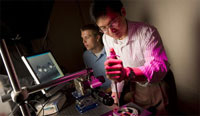Jumping droplets take a lot of heat, as long as it comes in a cool way
By By Richard Merritt | 16 Dec 2011
Microscopic water droplets jumping between surfaces that repel and attract moisture could hold the key to a wide array of more energy efficient products, ranging from large solar panels to compact laptop computers.
 |
| Chuan-Hua Chen, foreground, and Jonathan Boreyko. |
Duke University engineers have developed a new way of producing thermal diodes, devices which regulate heat to preferentially flow in a certain direction, effectively creating a thermal conductor in the forward direction and an insulator in the reverse direction. While thermal diodes can be made from solid materials, these solid-state diodes are not nearly as effective as ''phase-change'' thermal diodes that rely on vapourisation and condensation to transport heat.
These phase-change diodes can transfer over a hundred times more heat in the forward direction compared to the reverse, but with major limitations - they are dependent on gravity or restricted by a tubular configuration. These limitations severely constrain the application of phase-change thermal diodes, for example, in mobile electronics which require orientation independence or solar panels which require a large surface area.
The Duke engineers believe they have figured out a way to solve these limitations to existing thermal diodes by exploiting self-propelled water droplets, which can jump from a superhydrophobic (highly water-repellent) surface to a superhydrophilic (highly absorbent) surface, but not the other way around.
The results of the Duke experiments were published online in the journal Applied Physical Letters.
Chuan-Hua Chen, assistant professor of mechanical engineering and materials science at Duke's Pratt School of Engineering, and his research group was the first to actually videotape the self-propelled jumping motion of water droplets on a superhydrophobic surface. They found that the droplets literally jumped straight up and off the surface. In their current experiments, a superhydrophilic plate was placed opposite to the superhydrophobic one, creating an asymmetry crucial for the directional transport of heat in their thermal diode.
''When the superhydrophobic surface is colder than the superhydrophilic surface, the heat transport is very effective with phase-change processes, much like sweat taking away body heat; when the superhydrophobic surface is hotter, the heat flow is blocked and the diode behaves like a double-paned window,'' said Chen. ''Because the jumping droplets in our system are very small, gravity has negligible effect on them. Therefore, devices based on this approach can be oriented in any direction without the need to worry about gravity.''
Furthermore, Chen said, this approach can be easily scalable, which means technology based on this design can be used for thermal management of devices as small as computer chips and as large as building roofs. The jumping-drop approach uniquely combines large-area scalability, orientation independence, and effective thermal rectification into one device. This combination of properties is extremely useful for thermal diodes but has remained elusive until Chen's invention.
Typical phase-change thermal diodes rely on evaporating water to transfer heat from one surface to another, with gravity pulling the subsequent condensate down to restart the cycle again. For example, these so-called thermosyphons are in use in the Alaskan oil pipeline, in order to keep the heat from the pipes from melting the permafrost.
Chen believes that this new approach could make thermal diodes more practical and effective for a variety of applications.
These applications range from energy-efficient solar panels to smart ''skins'' of thermally adaptive buildings. For example, in the summertime a diode panel on a building could let heat escape out but prevent heat from creeping in. In space vehicles, thermal diodes can be used to regulate diurnal thermal fluctuations in the outer space, or even to harvest solar energy for powering satellites.
Chen's research is supported by the Defense Advanced Research Projects Agency. Other Duke members of the team are and Yuejun Zhao.




.webp)


























